Types of bathroom lighting – the 3 layers every space needs
Find the right types of bathroom lighting for your space with our expert guide
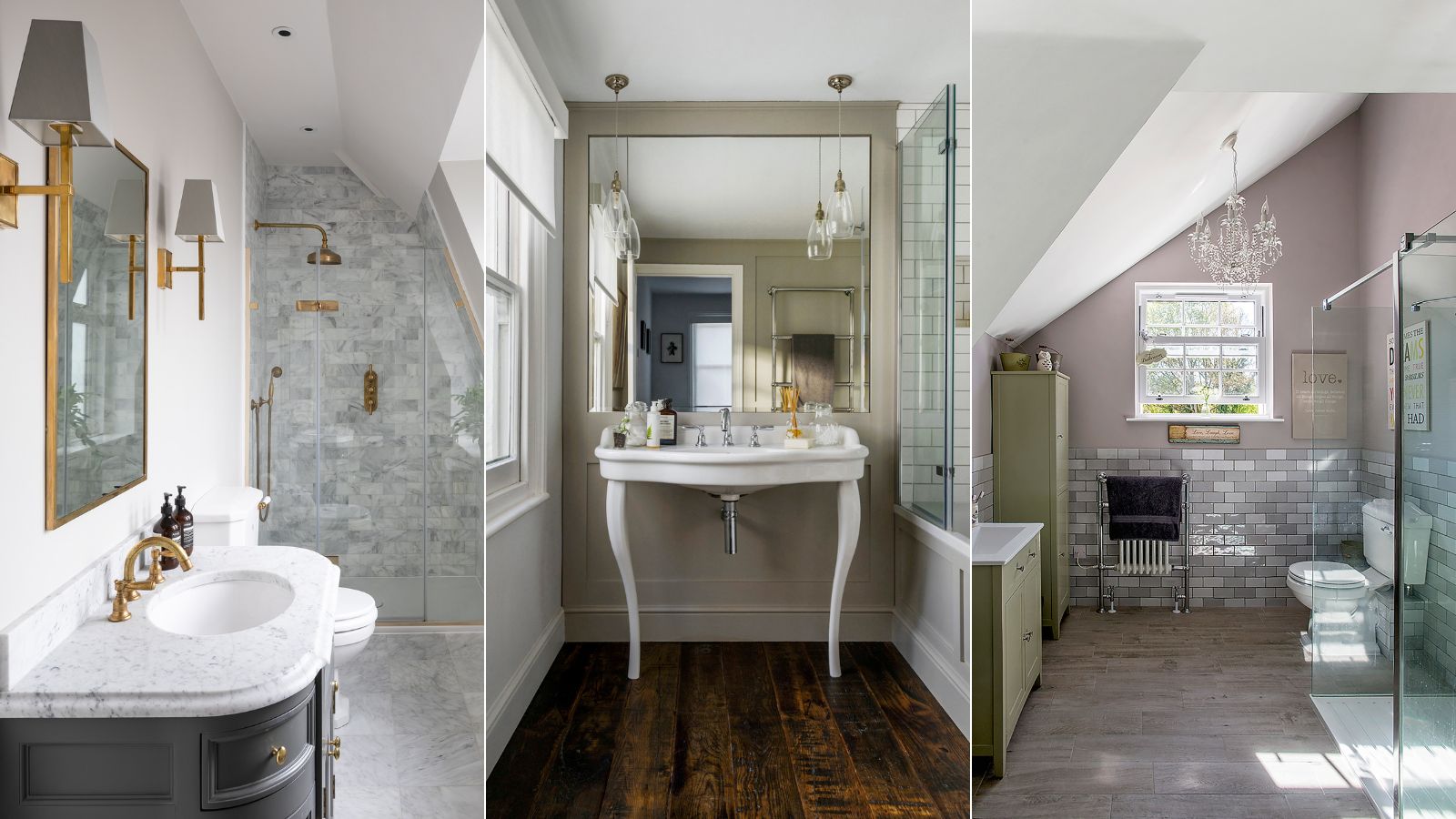

There are plenty of different types of bathroom lighting, from statement chandeliers and traditional wall lights to practical floor washers and recessed designs, however, the challenge is finding the best and right types to illuminate your space.
Bathroom lighting ideas not only offer functional illumination, they are also vital in bringing much-needed atmosphere to the space. However, the humidity of the space makes it a little more complicated to choose fixtures than in other rooms.
That said, there is a formula to follow when choosing the combination bathroom lighting types every space needs, and it's this: ceiling lighting + wall lighting + task lighting. So whether you are looking to brighten a primary bath or family space, discover the best and different types of bathroom lighting below.
Types of bathroom lighting
Historically, the bathroom was a functional space, but today it has a more nuanced role combining cleanliness with relaxation, and as such, when you are planning bathroom lighting, it must offer that same versatility: providing practical illumination while also creating a calming atmosphere, which can be achieve principally through a combination of ceiling, wall and task lighting.
‘With regard to lighting in bathrooms; we work on the principle of layered lighting with dimming controls to ensure sufficient task lighting when required but also the option to lower the lighting levels for a more relaxed environment,' explains Sophie Stevens, Creative Director at SGS Design Ltd. 'Ceiling recessed directional lighting is used to wash light down the walls, while wall lights on either side of the mirror will evenly illuminate the face from both sides, essential for make-up application.'
1. Start with ceiling lights

Pendant shades
Bathroom ceiling lights are a great way to introduce a new dimension and texture to your bathroom design. 'The right pendant can give you a major design moment, and make a space feel instantly elevated,’ says Katie Davis founder of Katie Davis Design.
Design expertise in your inbox – from inspiring decorating ideas and beautiful celebrity homes to practical gardening advice and shopping round-ups.
However, design moments aside, the role of the central pendant light is to provide overall ambient lighting. What it can't do, alone, is provide task lighting, so will always need to be supplemented with wall lighting and potentially with downlighters(see below).
There's more on bulbs, below, but note that it's important that your central light in particular has a warm LED bulb so that, used alone, the room still feels warm and welcoming. And remember, too, that the material and color of the shade will affect both light temperature and color, too.
As with all bathroom lighting types, ensure yours are rated for use within a bathroom.
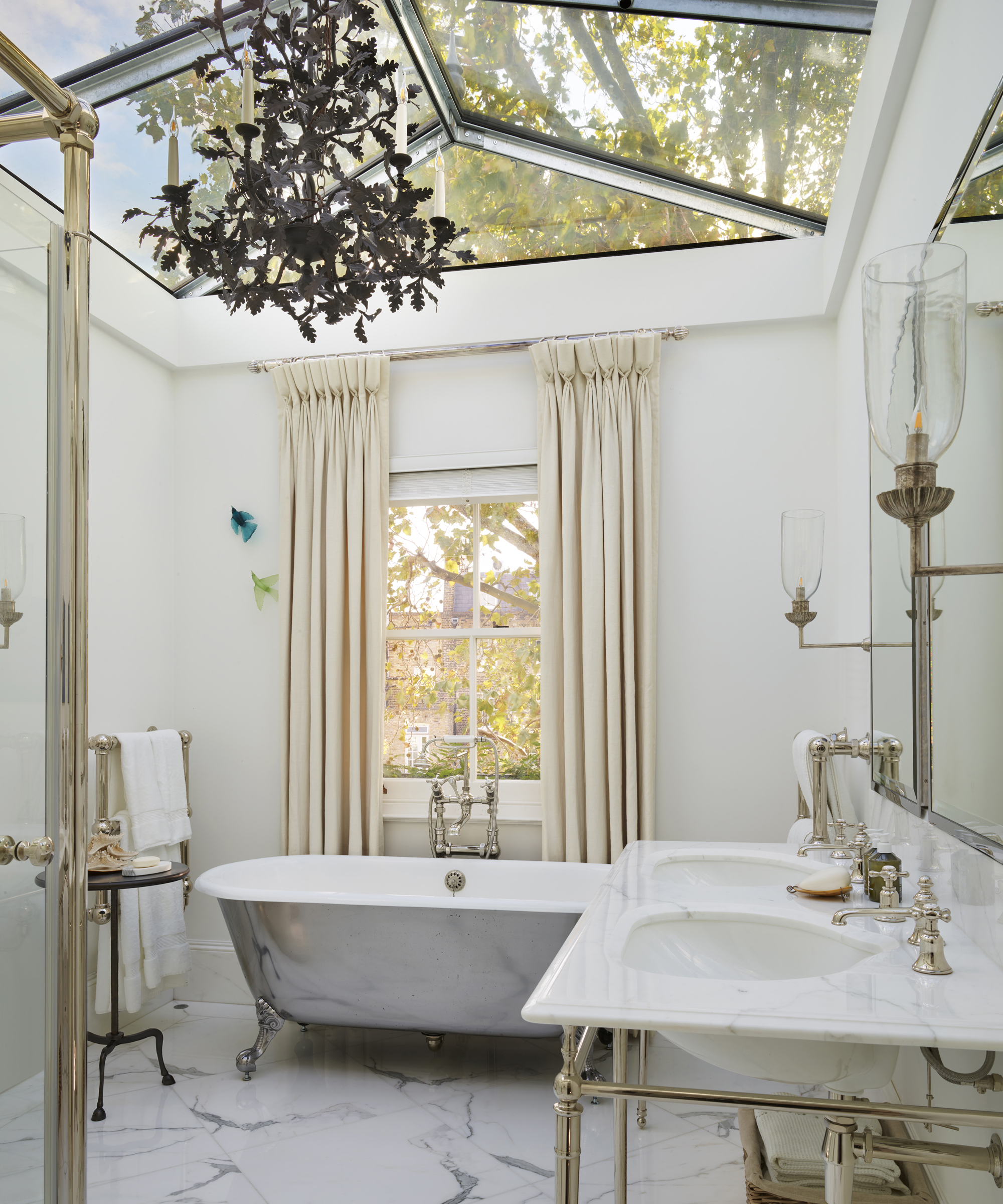
Bathroom chandeliers
If you can’t be glamorous in your bathroom, then where can you? Hung in the center of the room, bathroom chandelier ideas can elevate the entire space, giving even a modest bathroom a touch of luxury.
‘Lighting creates a huge impact, both on and off, so think about every area of your home. People are becoming more adventurous in the design of their bathrooms and so designing lighting that complements those schemes and pushes the boundaries of what is “normally” seen in these spaces is definitely a trend at the moment,’ says Niki Wright, co-founder of Lights & Lamps.
Chandeliers needn't be as large as the one in the room above, however, are generally grander and do therefore usually require more head space above them than most pendant lights (on average, the underside of a central pendant of any kind needs to be at least a foot higher than the top of the head of the tallest member of the household). This means they are often suited to larger bathrooms, and because the bulbs are exposed, they do throw out a decent amount of ambient lighting, so they are great for brightening dark bathrooms.

Over-bath pendants
While bathrooms are mostly transient spaces, only used for short periods of time, there is one exception to the rule. When bathing, you can spend a prolonged period of time in the same spot, therefore, it is important to consider your bathroom lighting types from this vantage point as well as from standing in the middle of the room. Opting for an over-bath pendant is a luxurious way to add atmosphere to your soak, offering enough light by which to read your book, without making the space feel stark or clinical.
Select a design with a clear glass shade to maximize light throw and prevent it from looking bulky or overwhelming a more modest interior scheme. 'Bulbous shades have a sense of fluidity that’s adaptable and will work in a variety of rooms,' says Rohan Blacker, founder of Pooky. 'It’s soft and subtle while the scale allows you to create impact.'
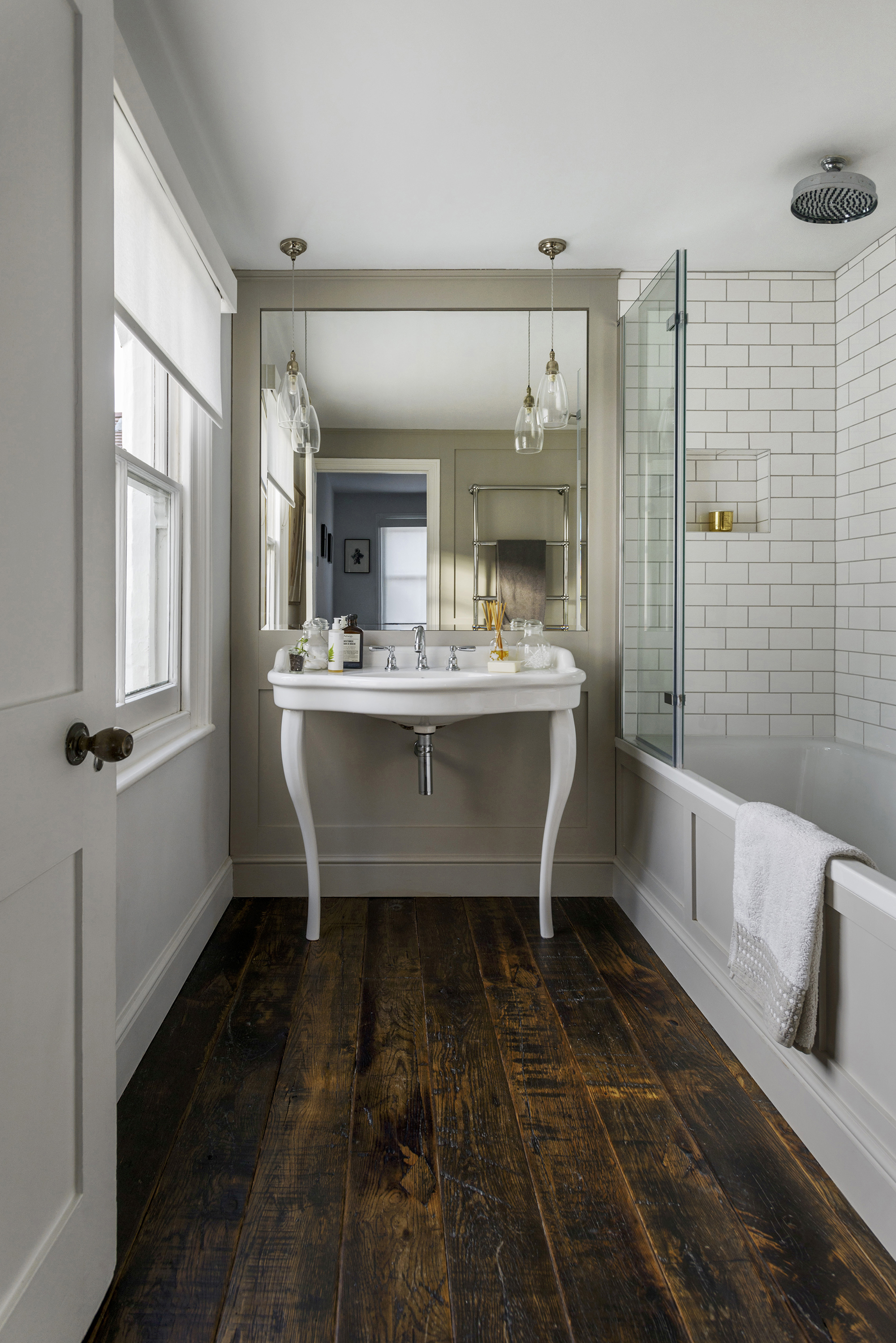
Pendants in front of mirrors
In a small bathroom, lighting plays a vital role. The right scheme can prevent the space from feeling cramped and unwelcoming. Thankfully there are lots of small bathroom lighting ideas that will help to brighten your petite space.
Positioning bathroom lights over mirrors will increase their light throw, with the mirror reflecting the light back into the room. This hybrid ceiling/wall light fixture type can be achieved with pendants hung from the ceiling or with wall lights that are attached directly to the mirror.
2. Add in wall lighting
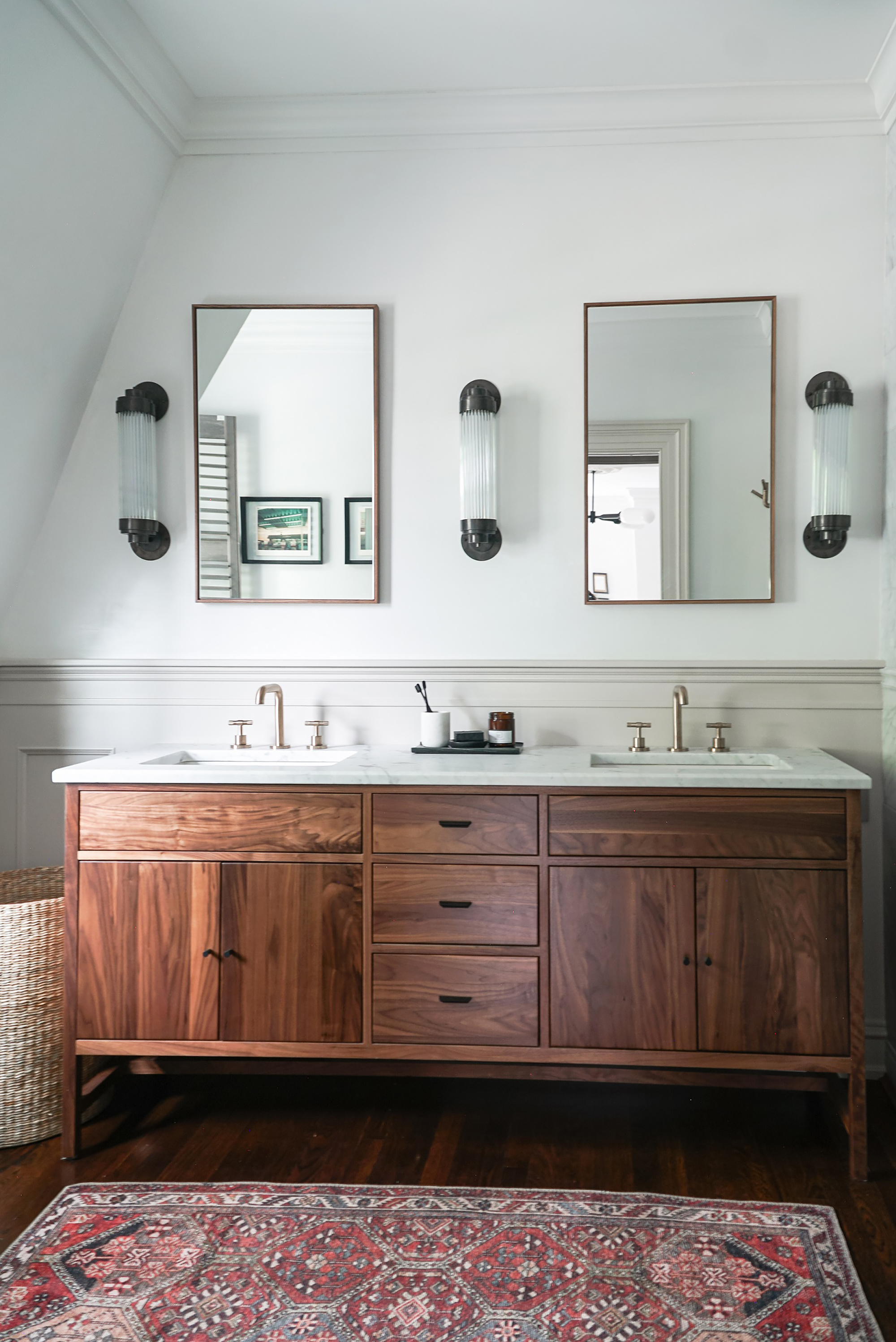
Wall sconce lights: glass
Bathroom wall lighting goes hand in hand with mirrors in endless combinations and configurations. One of the most popular, other than bathroom lighting over mirrors, is a symmetrical pair of wall sconces on either side of the mirror – or in this case two mirrors – or a bath.
This type of bathroom light is not only aesthetically pleasing: symmetry in interior design creates balance and a harmonious sense of structure, which is important for helping a small space feel curated.
Wall lights in a bathroom also ensure balanced light throw. Having lights at multiple angles ensures better illumination when shaving, doing makeup, and getting ready. The key is to ensure that the sconce design, and the height they are fitted at, doesn't shine light directly into your eyes when you are looking in the mirror. Doing so will make them unpleasant to use, but also throw harsh shadows on to your face.
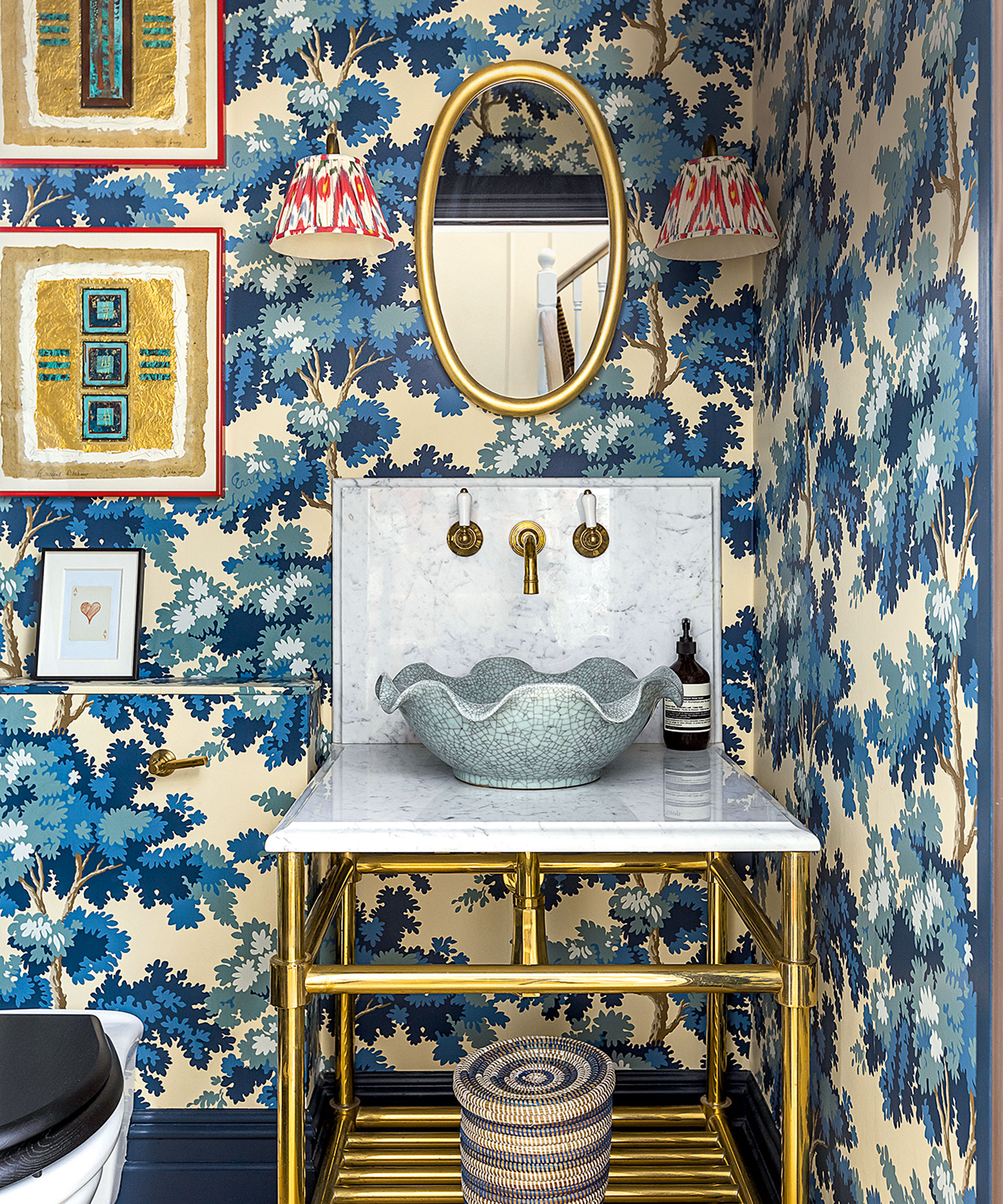
Wall sconce lights: fabric
Just because you are lighting a bathroom, it doesn’t mean that you can’t have fabric shades. There is a myriad of vinyl designs that are simultaneously beautiful and waterproof. However, when thinking about cloakroom ideas, powder room designs or guest bathrooms that aren’t subject to as much moisture, traditional fabric shades can be used to great effect.
In this bold space, designed by Barlow & Barlow, red fabric shades add a softer edge to the hard lines of the washstand, while its empire design complements the fluted sink, giving the whole space more of a lifestyle feel.
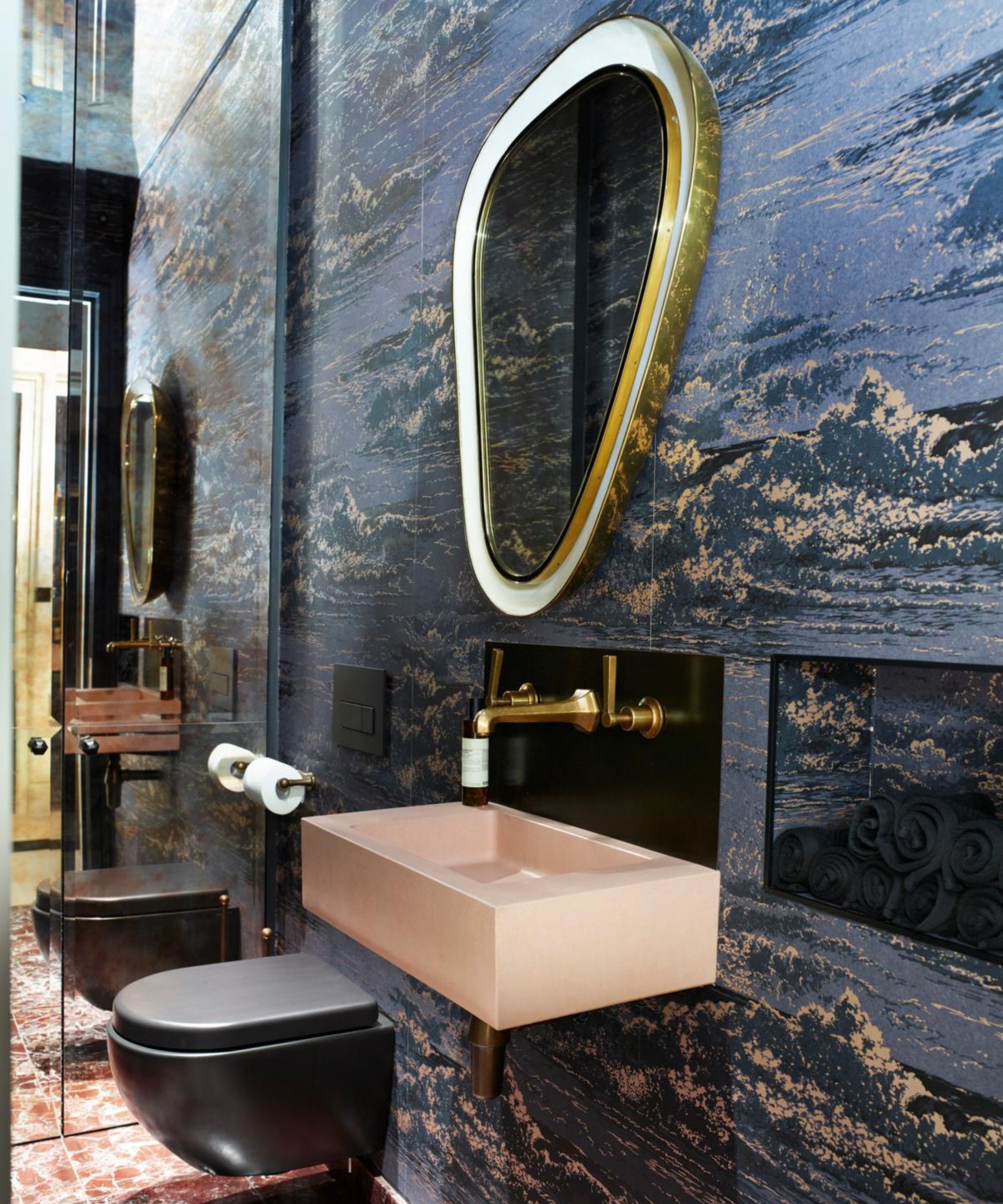
Bathroom mirror lighting
From a functional point of view, a bathroom mirror that has lighting within the fitting is the best type of bathroom lighting for shaving and putting on makeup by. This is because it provides soft lighting all around the face, rather than from the sides or above only.
Mirror lights often come with LEDs built in and these can often be very white (often called 'cool daylight'; if you want a softer glow (or, 'warm light'), like the one above gives you, ensure you check the bulbs' warmth levels before you commit.
3. Complete the scheme with task lighting

Recessed in shower lighting
Shower lighting is designed to be highly practical, especially if your shower is housed in an enclosed corner of the room. Recessed downlights are best for this space, where the room is limited.
If opting for in-shower lighting, then IP65 fittings are a must. These can withstand jets of water being pointed at them from any angle, though cannot be submerged. Pair this with bathroom ceiling lighting above the bath to bring texture and ambient lighting to the space.
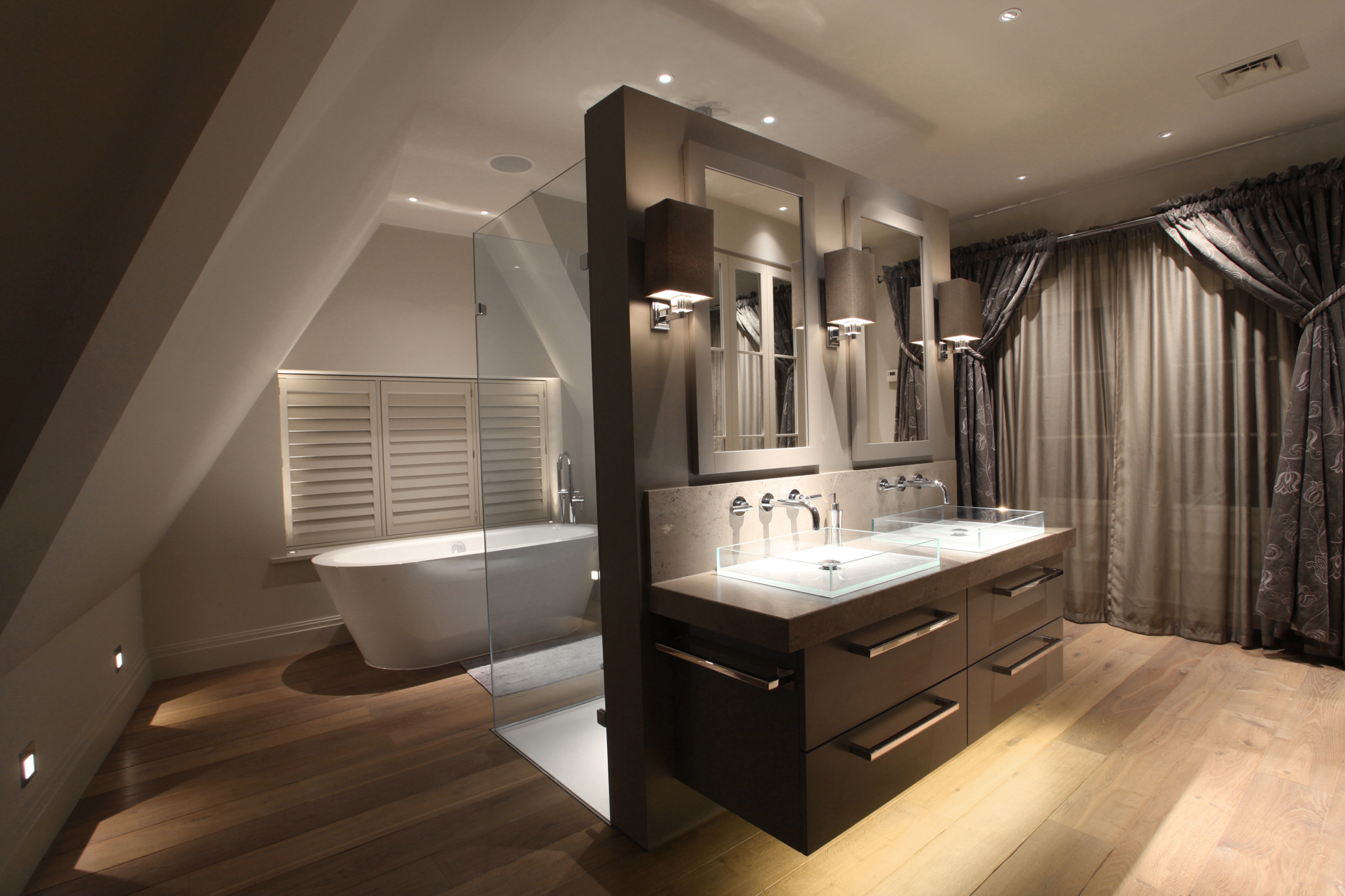
Low-level floor washers
We've all had to venture into the bathroom in the middle of the night and had to make the decision whether to stumble through in the dark or to fully wake ourselves up with the bright lights. Thankfully, a bit of forward planning offers the perfect middle ground.
'In all our bathrooms we incorporate a "pee" light, usually a low-level floor washer on a motion sensor, so if you need to use the bathroom at night, a soft glow will guide you through the space without fully waking you up,’ says Sophie Stevens, Creative Director at SGS Design Ltd.
In this bathroom, John Cullen Lighting's Oslo floor washers provide practical yet subtle illumination, ideal for navigating the space after lights out.
This type of lighting suits modern bathrooms more than period style rooms but it is a useful ploy for adding softness and layering to a room that's dominated by hard surfaces. It can also help increase the feeling of space, making a small bathroom look bigger.
Do you need a special type of light for a bathroom?
Yes, you do need a special type of light for a bathroom. Bathroom lighting types come with additional considerations due to the high moisture content of the room. As a result, the bathroom is divided into lighting zones.
Zone 0 is lighting that is in the bath or shower; Zone 1 is the area above the bath or shower to a height of 7.4ft from the floor; then Zone 2 covers the area 2ft outside of the bath and to a height of 7.4ft from the floor, as well as a 2ft radius from any faucet. Each of these zones has a minimum IP (ingress protection) rating – from the immersion-proof IP67 for Zone 0 to IP44 for Zone 2. For Zone 1, a minimum of IP45 is required but a rating of IP65 is generally recommended.
Should bathroom lighting be soft white or daylight?
The bathroom lighting type you choose when it comes to bulb warmth really depends how you use your space. Warm or soft white will make the space feel inviting at night, making it ideal for a relaxing soak. If however, you favor a shower in the morning and use the bathroom for shaving and putting on makeup, then a daylight mimicking bulb will no doubt suit you better. Ideally, bulbs in different types of bathroom lighting fittings shouldn't vary wildly, but subtly different tones in ceiling lights (soft, warm) vs wall lights (soft, daylight) can give you the best of both worlds.
Can you put a motion sensor in a bathroom?
Yes, you can put a motion sensor in a bathroom. Preventing the need for hanging cords or switches outside the room, they are perfect for low-traffic rooms where you are likely to forget to turn off the lights. Plus, since they go off automatically, they can help to reduce your energy bills too. However, if opening for automatic lighting, be sure that your fan operates on a separate circuit to prevent a build-up of moisture in the space.

Having graduated with a first class degree in English Literature, Holly started her career as a features writer and sub-editor at Period Living magazine, Homes & Gardens' sister title. Working on Period Living brought with it insight into the complexities of owning and caring for period homes, from interior decorating through to choosing the right windows and the challenges of extending. This has led to a passion for traditional interiors, particularly the country-look. Writing for the Homes & Gardens website as a content editor, alongside regular features for Period Living and Country Homes & Interiors magazines, has enabled her to broaden her writing to incorporate her interests in gardening, wildlife and nature.